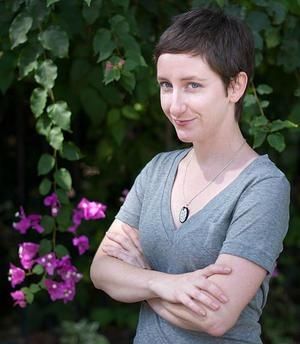How Many Women Does It Take to Change Wikipedia?
Smithsonian Archives’ Wikipedian-in-Residence Sarah Stierch is determined to bridge the gender gap on Wikipedia
/https://tf-cmsv2-smithsonianmag-media.s3.amazonaws.com/filer/20120404121011editathonthumb.jpg)
Sarah Stierch, the Smithsonian Archives’ new Wikipedian-in-Residence, freely admits there are some drawbacks to crowd-sourcing an encyclopedia.
“When you have the world writing the world’s history, you’re going to have: Abraham Lincoln, George Washington, General Custer, John F. Kennedy, maybe Jackie O,” she says. “And then you’re going to have ‘Seinfeld,’ Justin Bieber, The Hunger Games, and Lady Gaga. The end. That’s the history of the world.”
Since Wikipedia’s birth in 2001, the non-profit website has ballooned to almost 4 million articles in English and has versions in 283 languages. Readers write the articles, correct mistakes, and police the database for “vandalism” (by nominating frivolous or unreliable articles for deletion). But not all Wikipedia articles are created equal.
“Seinfeld episodes are some of the best, well-sourced articles out there,” Stierch says in exasperation. “Don’t get me wrong; it’s a classic American television show, I love it. But then you have a stub for some of the most important female scientists or artists on Earth? What’s going on here?”
Stierch, in conjunction with the Smithsonian Archives, is working to change that. On March 30, shortly after Stierch started her residency, the Archives hosted “She Blinded Me With Science: Smithsonian Women in Science Edit-a-Thon.” Ten Wikipedians showed up, armed with laptops and ready to tackle the significant dearth of articles on notable female scientists. Smithsonian archivists stood by to help the Wikipedians sort through the Archives’ and Libraries’ resources, both online and offline. Each editor chose a name or two from a list compiled by the archivists and started digging through the records. Many articles had to be started from scratch. Stierch has made it her mission to get more women on Wikipedia, both as editors and as subjects.
“This is the most women I have ever seen at an edit-a-thon,” Stierch declared at the beginning of the four hour session, surveying the seven women in the room.
According to the last Wikimedia Foundation editors survey, only nine percent of Wikipedia editors are women, down from 13 percent in 2010.
“The majority of the editors are white males around 30 years old with higher education, a bachelors or masters degree,” Stierch says. “So, we’ve got a group of smart people, but just like history, it’s being written by middle-aged white guys.”
Before starting the residency with the Archives, Stierch had started coordinating edit-a-thons all over the world for Women’s History Month, both to encourage more women to get involved in Wikipedia and to improve the website’s coverage of women. At the same time, the Archives staff had been writing blog posts on women in the collections and updating their Women in Science Flickr set. When Stierch joined, they put their heads together and came up with the Women in Science Edit-a-Thon.

“One of the biggest complaints we get is that women who are involved in science don’t always have a great chance of having their articles saved on Wikipedia, because people don’t think they’re notable enough,” Stierch says. “But if you’re in the Smithsonian Archives, you’re notable. And I’m so happy that the Archives wants to work with us to document that.”
Among the edit-a-thon’s targeted scientists were Mary Agnes Chase, a botanist who funded her own research in South America at the turn of the 20th century because it was considered inappropriate for women to do field work, and Mary J. Rathburn, a Smithsonian zoologist from the same time period who described over a thousand new species and subspecies of crustaceans.
Midway through the edit-a-thon, Stierch tweeted, “We’ve already had numerous articles nominated for deletion. But we’ve saved them.”
This isn’t Stierch’s first stint at the Smithsonian; last year, she was a Wikipedian-in-Residence at the Archives of American Art, which contributed 285 images to Wikimedia Commons, the free image bank of Wikipedia. Now a Museum Studies graduate student at the George Washington University, Stierch sees a lot of overlap between Wikipedia and the Smithsonian’s mission: the increase and diffusion of knowledge. In spite of the need for more demographical diversity, this mission has already connected very different people with many varied interests.
“I have met everyone from people who have their PhDs, who are lawyers, who have books on the New York Times bestseller list, who are jazz musicians, and punk rockers with mohawks,” Stierch says of the Wikipedian community. As Wikipedian-in-Residence, Stierch connects these tech-savvy Wikipedians, who need more resources, with Smithsonian archivists, who are eager to disseminate their vast stores of information to a wider audience (Wikipedia has an estimated readership of 365 million people).
“So many people who aren’t involved in the museum feel distant from the curators and the archivists,” she says, waving toward the Edit-a-Thon “war room.” “Knowing they’re all hanging out in the same room over there makes me very happy.”
/https://tf-cmsv2-smithsonianmag-media.s3.amazonaws.com/accounts/headshot/ATM-aviva-shen-240.jpg)
/https://tf-cmsv2-smithsonianmag-media.s3.amazonaws.com/accounts/headshot/ATM-aviva-shen-240.jpg)